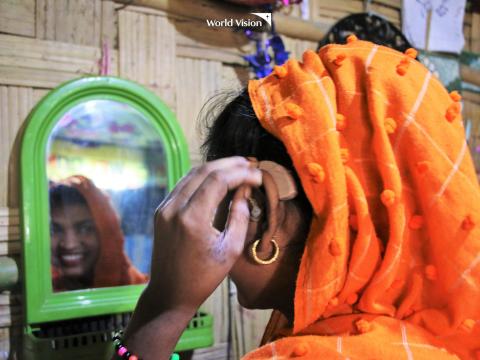Azida takes her life back after experiencing hearing loss

Six years ago, Azida and her parents fled to Bangladesh to escape persecution for being part of the Rohingya community. Her family took shelter in the camps in Bangladesh’s Cox’s Bazar district with other Rohingya families in 2017. Since then, more than 700,000 Rohingyas have sought refuge in Bangladesh.
Azida spent the next few years living in a 10-square-foot shelter with her parents and four sisters. Supplies were short, and the family relied on humanitarian aid for their survival. Three years later, Azida noticed a ringing noise in her left ear and realised she had lost hearing in that ear.
“I woke up one day and experienced discomfort in my left ear, but I thought it would cure itself,” said Azida.
But the problem persisted, and her father eventually took her to their camp’s health centre but that led to no improvement for Azida. Her condition worsened and she soon lost hearing in both ears. Azida was ridiculed by her neighbours for her condition, and she became shy and withdrawn as a result.
“People spoke to me at a higher volume, and I was mocked for my hearing loss. Their taunts were hurtful, I cried every night praying I woke up cured,” said Azida.
Azida’s story reached a community volunteer within the camps, who immediately informed a World Vision disability inclusion coordinator, Debashis Das. Debashis worked with the Australian Humanitarian Partnership’s (AHP) project, which is implemented by World Vision Bangladesh’s Rohingya Crisis Response (BRCR). The AHP project placed emphasis on the well-being of people with disabilities through inclusive pathways. The project is implemented in both the Rohingya camps and host communities at Cox's Bazar to prevent, prepare for, respond to, and recover from disasters and other humanitarian crises and save lives and alleviate suffering. One of the priority areas of this project is disability inclusion through providing supportive devices to ensure accessibility and meaningful participation in the community for people with disabilities.
Over the next six months, Debashis and his team worked with Azida and provided her support through the Centre for Disability in Development (CDD), a technical partner of the DFAT-AHP. The CDD diagnosed Azida’s condition and recommended the proper device to help her. World Vision Bangladesh bought the device for Azida and, to the delight of all, Azida was able to hear when she used the device. The CDD also conducted a campaign in Camp 10 to raise awareness for disability inclusion. As for Azida, she still becomes emotional when remembering the day, she could hear again.
“It was the happiest day of my life. When I realised I could hear clearly again, I could not hold back my tears,” said Azida.
World Vision staff regularly follow up with Azida about her treatments, and now she is leading a happy life.
Mokkaram Siddiqui, Camp Coordinator of World Vision, said that, like Azida, a total of 248 persons with disabilities in the Rohingya camps and host communities received different types of assistive devices according to their needs under the AHP project. These devices help to improve the quality of life and ensure meaningful participation in the community of persons with disabilities. The hope here is that the negativity around disability will fade and people in these vulnerable conditions, especially in places like refugee camps, will be able to contribute to their communities and live more fulfilling lives.